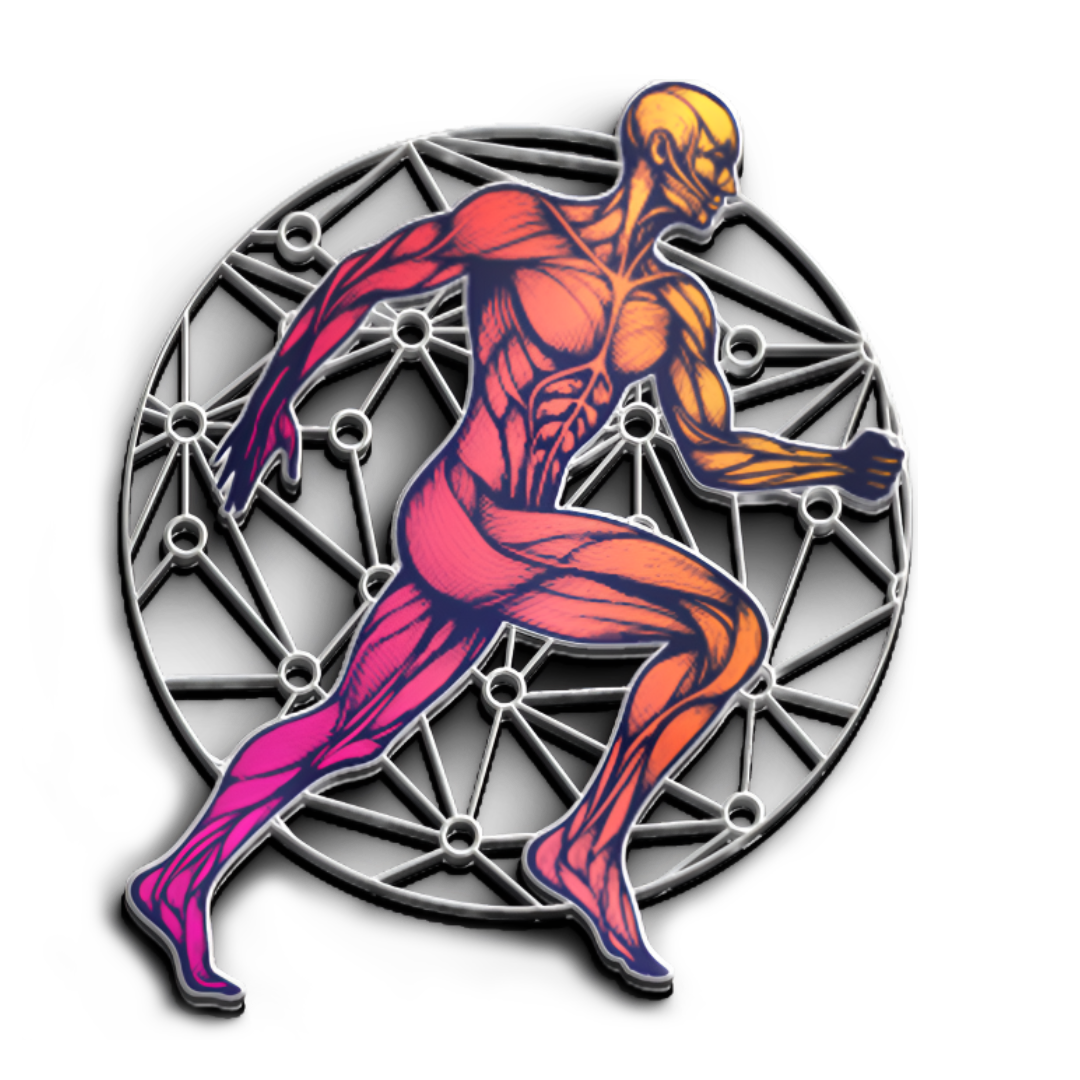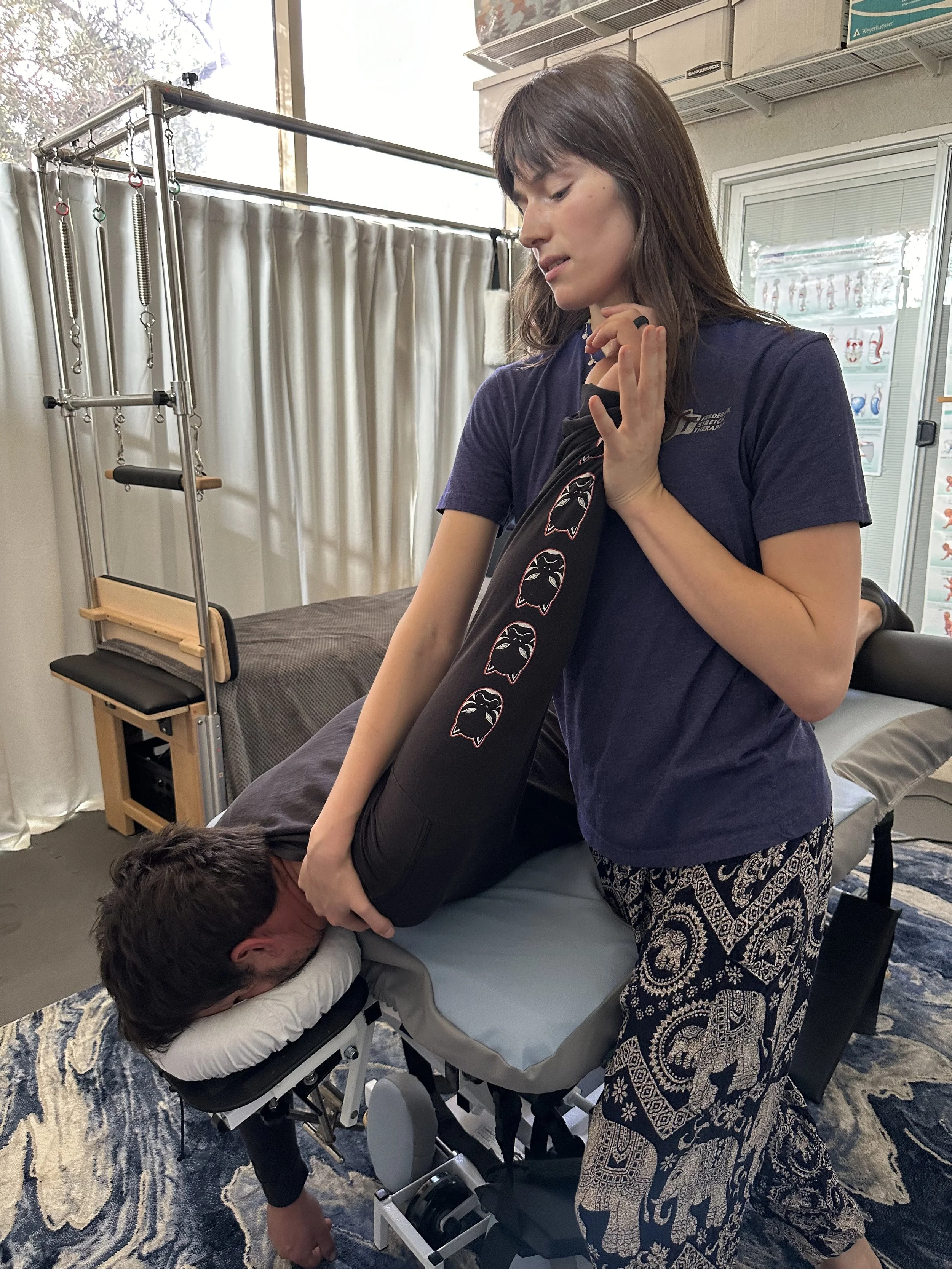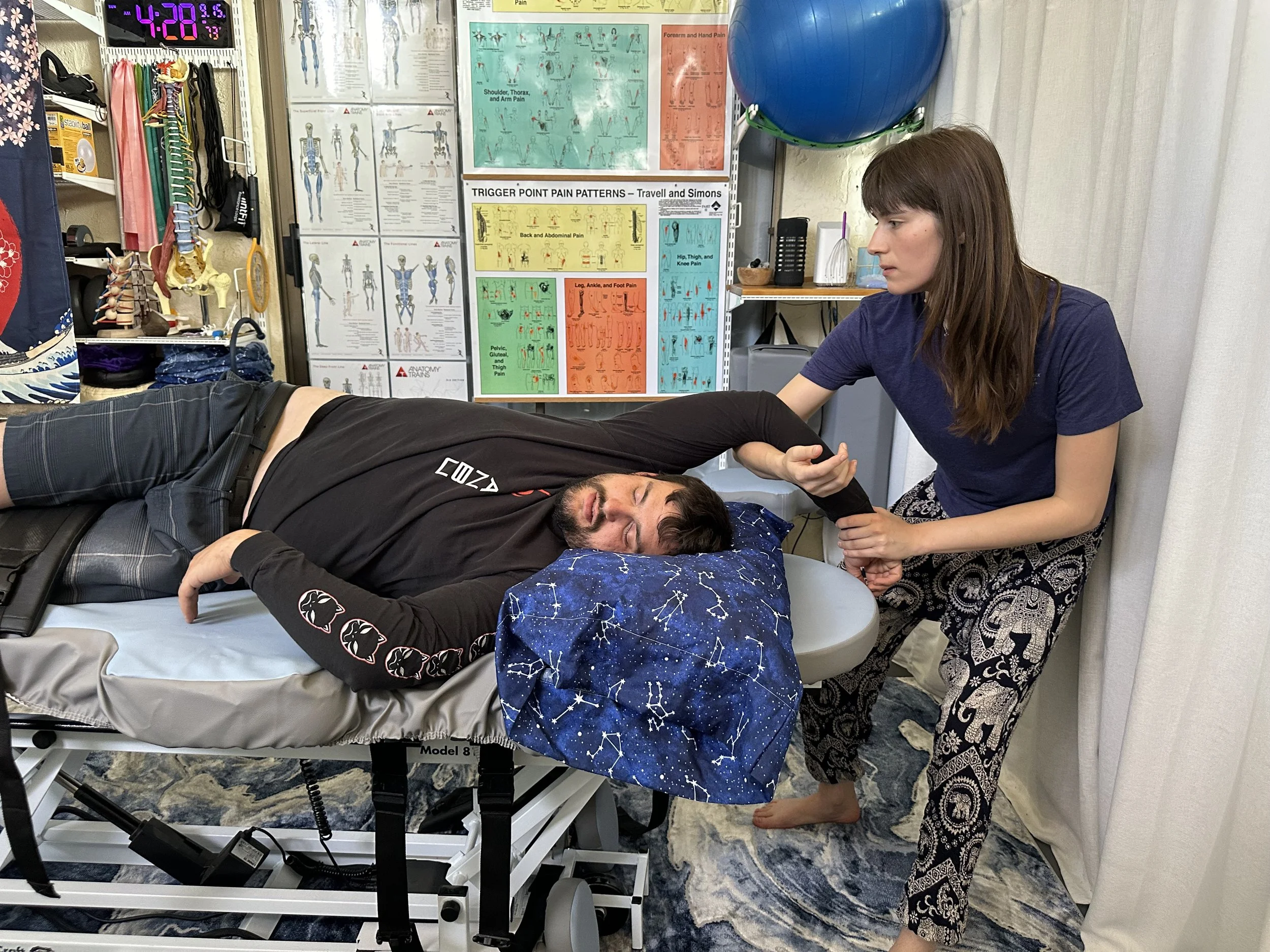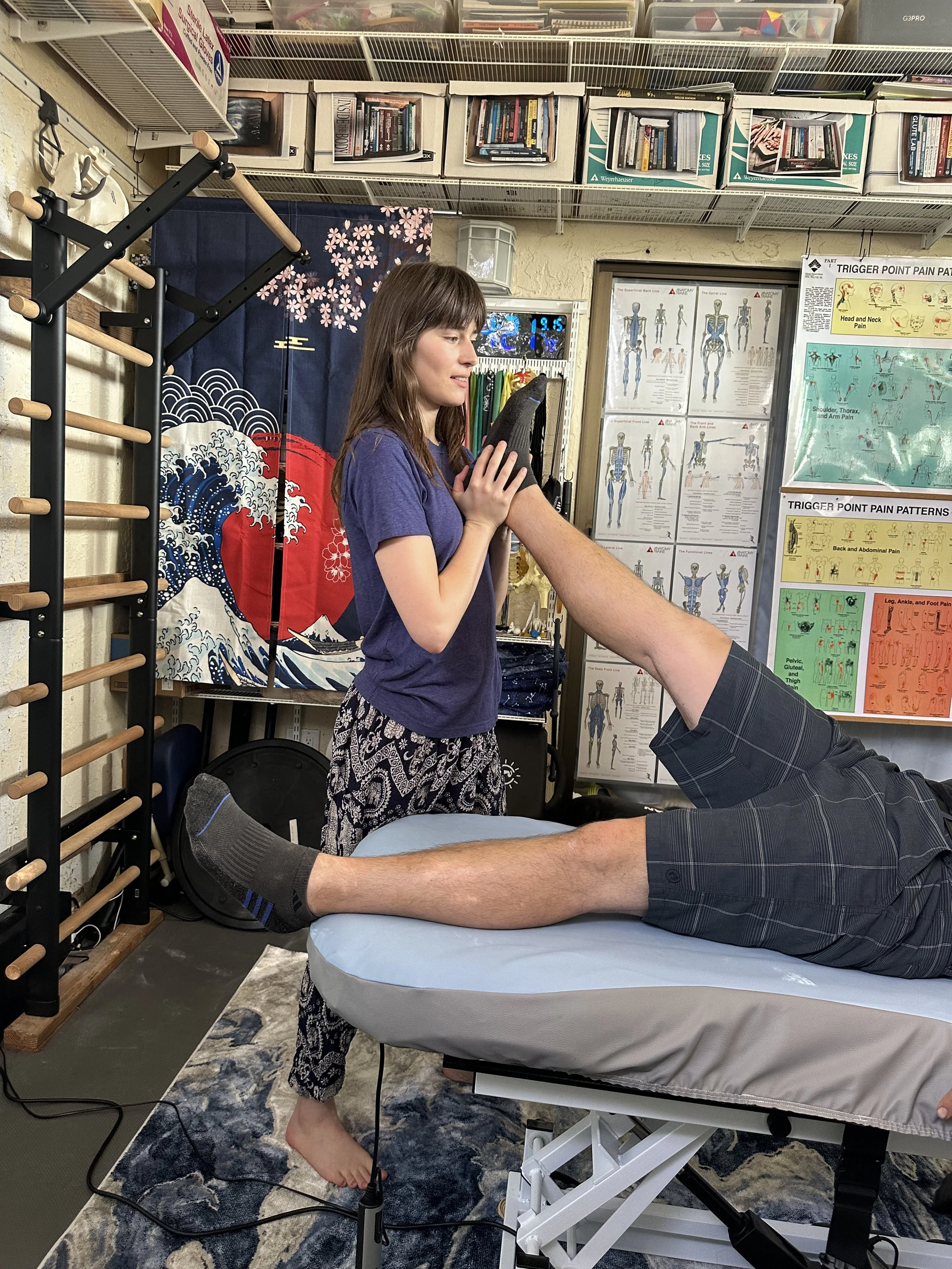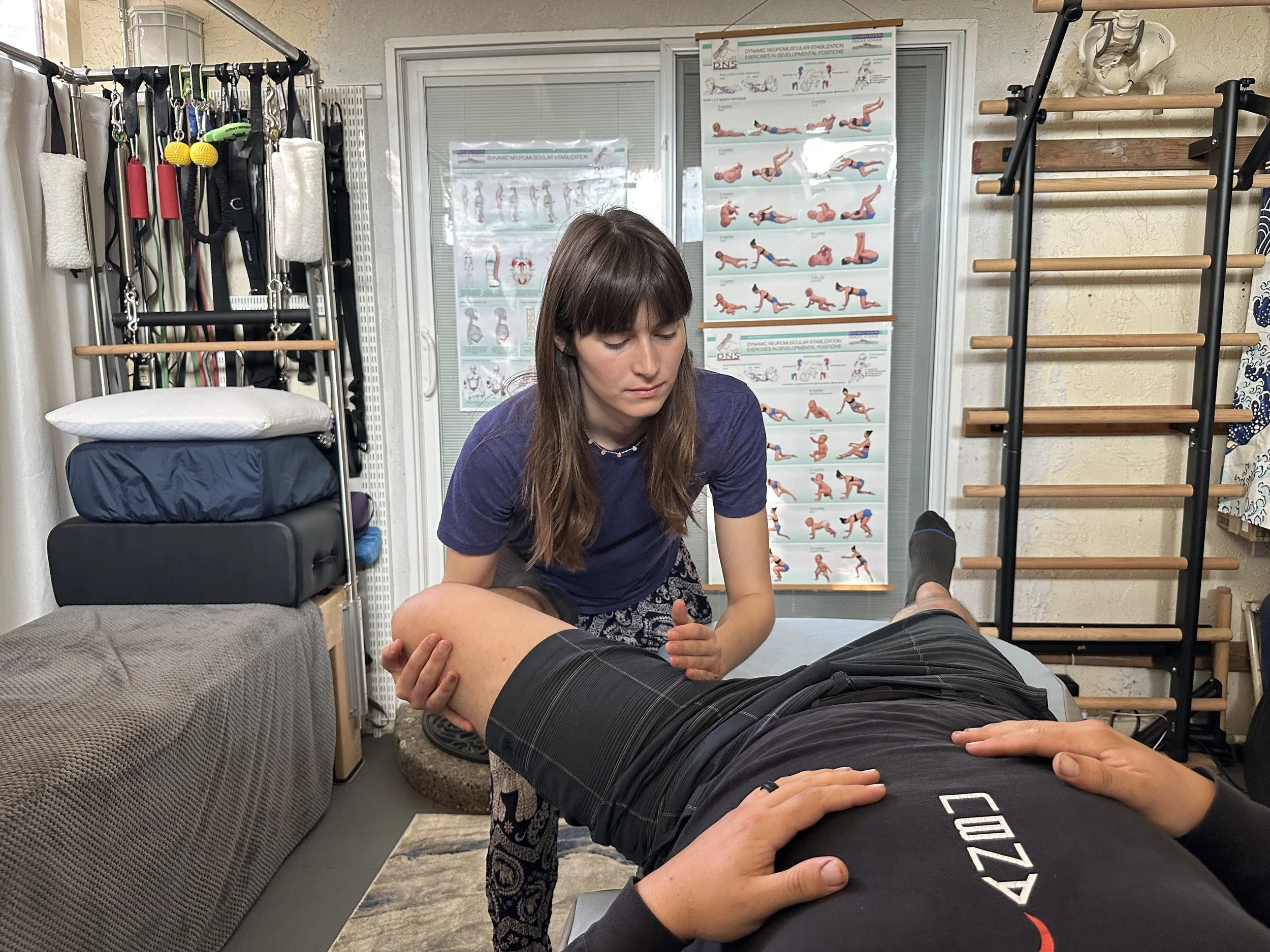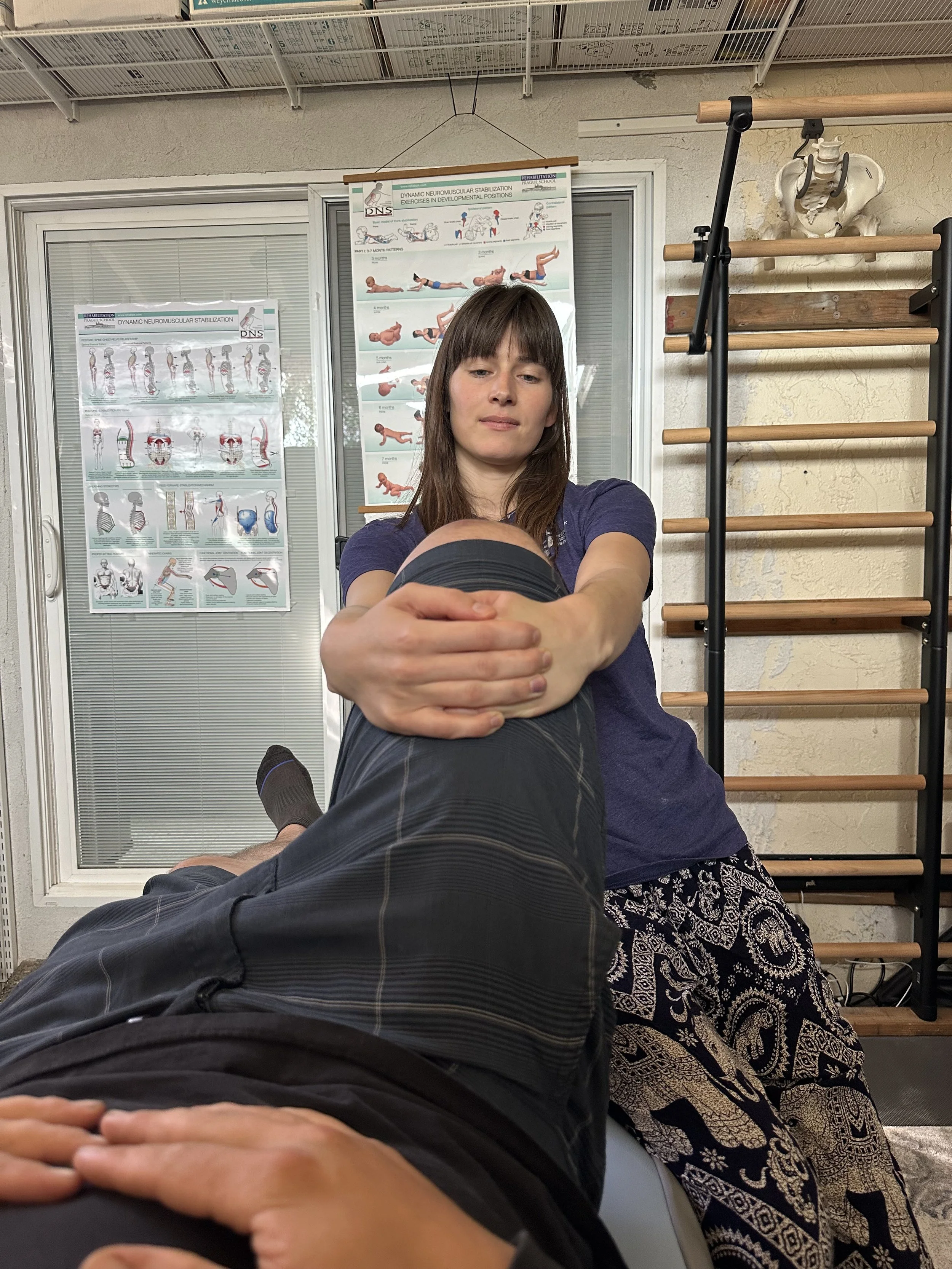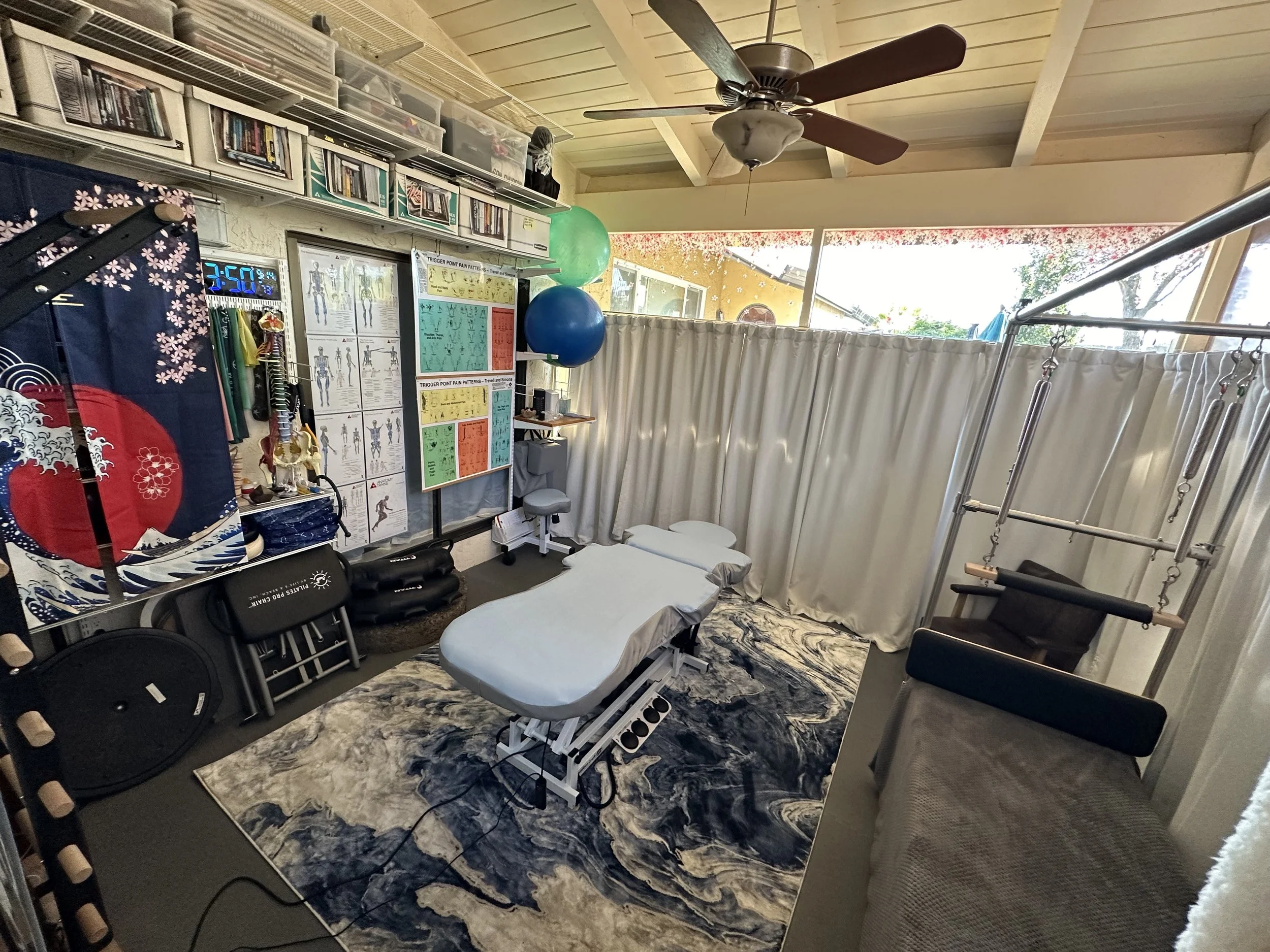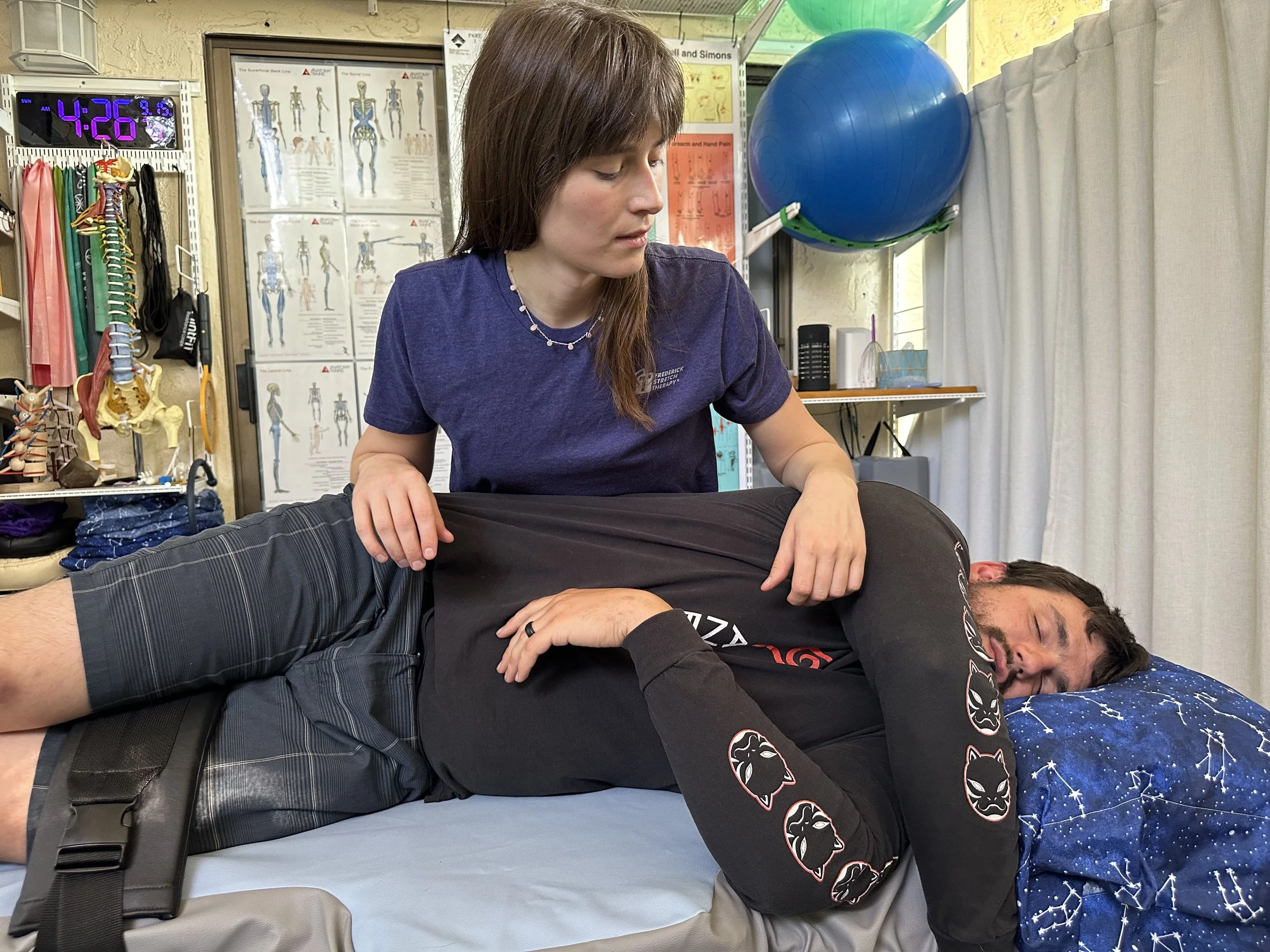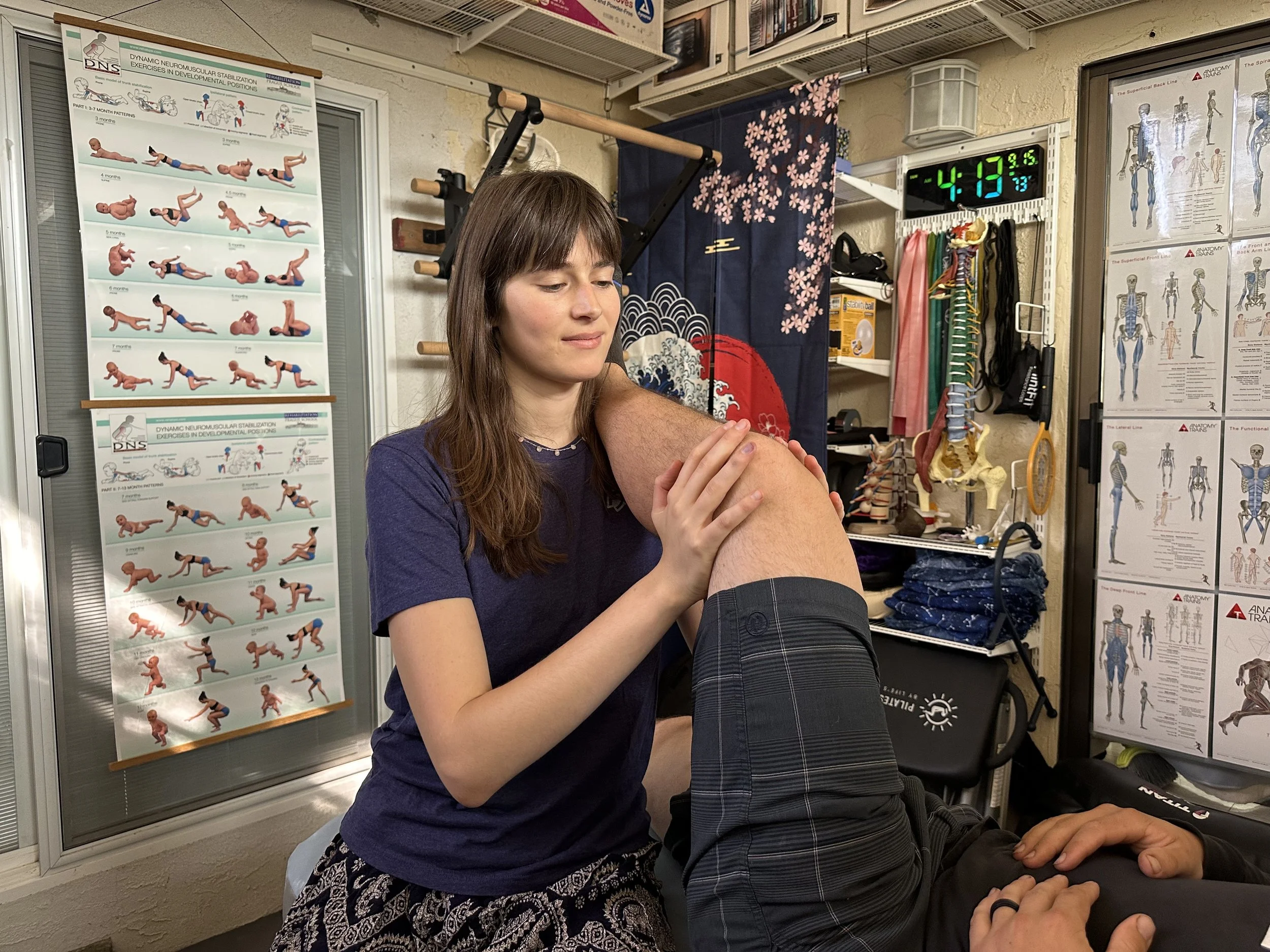HOW IS FASCIA STRETCH THERAPY DIFFERENT?
FASCIA STRETCH THERAPY (FST) is a dynamic, assisted stretching technique that targets the fascia—the connective tissue network enveloping muscles, bones, joints, nerves, & organs. Unlike traditional stretching methods that focus on muscles, FST addresses the entire neuromyofascial system down to restrictions in the joint capsules to rebalance the bio-tensegrity (equilibrium between tension & compression) of the body and enhance overall movement and posture.
During an FST session, your certified practitioner guides you through gentle, pain-free stretches using traction, compression, & rhythmic movements synchronized with your breath. This approach not only releases tension and adhesions in the fascia but also promotes better circulation, nervous system regulation, and joint stability.
Each session is tailored to your individual needs, with the practitioner continuously assessing and adjusting techniques to address specific restrictions and imbalances. This personalized method allows FST to effectively restore balance, enhance performance, & support recovery from injuries.
WHAT TO EXPECT IN YOUR FST SESSION
1. CONSULTATION & ASSESSMENT
We'll begin by reviewing your intake form and discussing your goals and areas of concern. A brief assessment of your posture and movement will help tailor the session to your needs.
2. ASSISTED STRETCHING SESSION
You'll relax on a specialized table with comfortable straps to stabilize your body. Through gentle, guided movements synchronized with your breath, we'll stretch your body in ways that are difficult to achieve alone, focusing on releasing tension and improving mobility.
3. POST-SESSION GUIDANCE
After the session, we'll reassess your range of motion and discuss any noticeable changes. You'll receive personalized self-care tips or stretches to maintain and enhance the benefits between sessions.
Many clients report feeling more relaxed, mobile, and aligned after just one session. Regular FST sessions can lead to lasting improvements in posture, flexibility, and overall well-being.
BENEFICIAL EFFECTS OF FST
ENHANCE FLEXIBILITY & MOBILITY
By improving tissue glide and joint function, FST helps you move more freely and efficiently in daily life and activities.
RELIEVE PAIN & TENSIONS
FST gently releases fascial restrictions, easing joint and muscle discomfort while calming the nervous system for lasting relief.
ACCELERATE RECOVERY & PREVENT INJURIES
Boost circulation, reduce inflammation, and support healing—ideal for post-workout recovery or injury prevention.
IMPROVE POSTURE & STABILITY
FST rebalances your body's tension patterns (bio-tensegrity), promoting better alignment and reducing compensatory movements.
REDUCE STRESS & IMPROVE SLEEP
Rhythmic, assisted stretching calms the nervous system, helping you feel more relaxed and sleep more soundly.
BOOST PERFORMANCE & BODY AWARENESS
FST enhances physical performance by improving coordination & mental resilience while increasing internal awareness of movement patterns.
FST FAQs
-
FST is suitable for people of all ages, lifestyles, and body types.
People with chronic or complex pain situations looking for relief
Anyone looking to restore mobility, including post-injury, surgery, or joint-replacement
People on the hypermobility spectrum (HSD) including Ehlers-Danlos (hEDS)
People who sit a lot — office workers, long-distance commuters, & those living a more sedentary lifestyle
Seniors or individuals who struggle to be active on their own.
Athletes at any level including professional, fitness enthusiasts, & weekend warriors
Really anyone cleared by their physician for stretching and physical activity.
-
FST works differently from other bodywork or self-stretching methods by engaging not just muscles but the entire neuromyofascial system — including muscles, joints, bones, and nerves (even organs and vessels).
Key components of FST are the use of traction and compression to separate the tissues that are stuck together and stabilize the tissues that have too much movement. The goal is to rebalance the body’s bio-tensegrity (the equilibrium of tension and compression throughout the body) for better force distribution though the joints so no one area receives too much strain.
-
FST is designed to be pain-free. It is radically opposite from the "no pain, no gain" philosophy. So NO, FST does not and should not hurt.
Stretch awareness is a normal part of the session, however the overall intention is 100% avoidance of pain and joint pinching. Active communication between the practitioner and client is key to keeping the session safe and productive.
FST focuses on creating an environment where the nervous system can relax and feel safe enough to allow meaningful tension release in the muscles and fascia. After a session, you'll feel deeply relaxed with increased pliability, comfort, & ease in your joints and muscles.
-
After an FST session, people often experience a sense a deep relaxation with increased flexibility in their joints and muscles. Many people also enjoy a restful, deep sleep the night following their session.
It's not unusual for some people to experience some soreness the next day, which is a perfectly normal response post-session as inflammation and waste products leave the tissues and healing, new blood comes in. This usually subsides within a day or 2, leaving you feeling more relaxed and often with reduced pain and discomfort.
FAST AFTERCARE:
HYDRATION: Drink plenty of water with electrolytes throughout the day to help rehydrate your fascia and muscles.
NUTRITION: The body needs protein in order to rebuild, so make sure to eat some or take amino acids to help with the repair we have enabled the body to perform. Avoid sugars and processed foods that cause inflammation and soreness to linger longer than necessary.
ACTIVITY: While it's usually best to take it easy after your session, some moderate activity is fine if you prefer. Listen to your body, and don't push it if it is telling you it needs rest!
-
Please wear loose or stretchy clothing, similar to what you would wear for a workout or yoga class such as shorts, sweatpants, leggings, loose T-shirt, etc.
PEASE NO JEANS.
The session is performed fully clothed so no need to undress.
-
Clients will typically notice an immediate increase in mobility and a substantial reduction of pain within the first few FST sessions.
Be aware that everyone's starting place is different and some conditions may require treatments over time for complete resolution & healing.
-
Great Question!
The frequency/length of FST sessions depends on your specific needs/goals, the type of pain/challenges you're experiencing, & your personal exercise/mobility routines.
For acute pain or discomfort, Nelle typically recommend sessions 1-2 times per week. (Check out the TRANSFORMATION JOURNEY or LIVE IN BLISS PACKAGES)
Once you have achieved your goal/your pain subsides, periodic maintenance is suggested with the recommended frequency being something you discuss with Nelle.
As a rule, longer sessions closer together achieves results faster; however you will still progress even if you can only do sessions periodically.
Needs can be separated into 4 different categories, and below are the recommendations for each.
ACTIVE HEALING
This is the acute stage of healing after an injury or the starting point of addressing a long-term problem.
Longer sessions (60 minutes minumum. 90 minutes best) closer together (1x/ week minimum. 2x/week best) are recommendedat this stage for the most efficent results.
MAINTENANCE
A generally healthy person with minor body/joint problems will benefit from sessions on a maintenance schedule such as (60-90 minutes, 1x- 2x/month).
LONG-TERM MANAGEMENT
A person in this category is dealing with (A.) chronic, long-term issues or (B.) conditions like congenital scoliosis or certain types structural damage from injury/surgery that could make complete healing difficult to achieve.
For chronic conditions that require healing over a longer timeline, I recommend discussing with your FST provider for a personalized plan of care as to how often/how long it is recommeded to receive sessions.
ATHLETIC/SPORTS PREP
For the day of athletic/sports events, a (45 minute) FST session at a quicker pace amps up the sympathetic nervous system to prepare the body for athletic activity by improving reaction time, flexibility, & strength for optimal performance.
For correcting body imbalances that affect athletic performance, longer restorative sessions of (60 or 90 minutes) are the way to go.
-
Absolutely! As someone with hypermobility herself, Nelle benefits greatly from FST and receives it regularly.
Every individual with hypermobility is unique, so sessions are tailored to their specific needs. While hypermobile people don’t necessarily need to increase their range of motion, FST focuses on improving joint stability, safe movement, and proprioception.
Sessions are adjusted to reduce or eliminate traction, support joints, and address specific restrictions in joint capsules that prevent normal movement. With gentle, collaborative techniques and open communication, FST ensures safety and effectiveness.
If you experience post-session discomfort, share feedback with Nelle so adjustments can be made for your comfort and progress.
-
FST offers significant benefits for athletes beyond addressing pain.
By enhancing flexibility, FST helps prevent injuries commonly associated with sports and physical activities. It also effectively addresses postural imbalances, movement dysfunctions, improper muscle firing patterns, and neural dysfunctions—all of which can contribute to injury if left unaddressed.
In addition to improving circulation and reducing of inflammation, athletes will heal better and recover faster in between events and training so they are and can stay at the top of their game.
-
I understand life happens and emergencies do come up, and since your appointment time has been reserved especially for you I ask for at least 24 hours notice if you need to reschedule or cancel.
Cancellations within 24 hours will be charged 50% of the appointment.
No-shows will be charged full price.
FST IN ACTION
